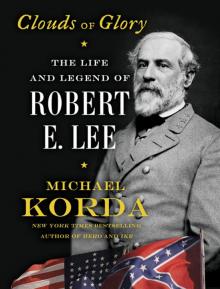- Home
- Michael Korda
With Wings Like Eagles: A History of the Battle of Britain Page 5
With Wings Like Eagles: A History of the Battle of Britain Read online
Page 5
As for the Germans, although they sent the last great dirigible, the Graf Zeppelin, out to cruise the British coastline in bad weather in order to analyze the signals from Dowding’s radar towers, they were thwarted by the fact that the radar operators, who could hardly fail to miss an object as large as the Graf Zeppelin, stopped transmitting during its flight around the coastline. The Germans failed to understand the means by which these signals were transformed into an orderly system of command and control. Yet, it was not radar that would escape their attention; it was the neat, methodical mind of Sir Hugh Dowding.
Throughout 1936 and 1937 Dowding painstakingly built the foundations of his strategy to protect England, putting the pieces together like those of a gigantic three-dimensional jigsaw puzzle. Almost as soon as he took command he sent in a modest request for £500 to construct his Operations Room at Bentley Priory, and chivvied architects, builders, the General Post Office (the GPO, which in the United Kingdom controlled and installed telephone lines), and the Office of Works to give him something that had existed before only in the form of sets for a futuristic film like Things to Come.
Today, of course, all this is old hat, familiar from countless movies and from innumerable televised rocket launches at Cape Canaveral, but in the mid-1930s it was the only thing of its kind in the world. Dowding moved fast, transforming the ballroom of Bentley Priory into a big, crowded amphitheater for a new kind of war, and using the graceful rotunda next door for the necessary teleprinters and switchboards. On the floor of the ballroom, he built an enormous, irregularly shaped table to represent the southern coast of England, the English Channel, and the northern coast of the continent, “from Edinburgh to the French coast, to Cherbourg, and from the Welsh border to the East of Belgium.”2 The surface of the map table was divided into squares, each one marked and identified with a letter of the alphabet. This was the “Filter Room.” Around the table would sit or stand a dozen or so young airmen and airwomen (at first the women were the wives of officers serving at Fighter Command Headquarters who had volunteered for the job, but by 1939 most of the “filterers” would be young women in the blue-gray uniform of the WAAF, who would soon be known, predictably, as the “beauty chorus”), each supplied with a box of counters, rather like those used in playing chemin de fer or roulette in a casino, and long stick with a bar at the end like that used by the croupier at the roulette table. Each “filterer” wore earphones, and some of them also wore a microphone suspended around the neck. Above the filterers was built a “gallery,” where the whole table could be observed from above by the officers charged with warning each Fighter Group of the situation as it developed on the board below, as well as by the naval liaison officer, a senior Royal Artillery officer with a direct line to the headquarters of the antiaircraft gunners and searchlight operators, and officers linked by direct lines to the Observer Corps, the police, the fire services, and those in charge of sounding the air-raid alarms. The filterers received information as it came in from the operation room in each Fighter Group, from the radar plotters on the coast, and from the observers on the ground; and once an enemy raid had been identified, they set up an identifying marker for it, showing its present position, the projected course of the raid, the height, and the number of enemy aircraft it contained, moving the marker with their long sticks as it progressed from the “enemy” coast, across the Channel or the North Sea, and toward one of the four Fighter Groups, each defending its own “Sector.” From the very beginning it was assumed, correctly, that the Luftwaffe attacks would not follow a straight, predictable course—there would be feints, sudden changes of direction and altitude, “phantom” attacks intended to draw the British fighters away from the intended targets and to create the maximum confusion. All this would have to be recorded instantly on the board, and analyzed.
Behind the table, on the wall facing the gallery, there was another big board with rows of colored lights on it, known, inevitably, as the “Tote Board” (after the board at a race track that shows the horses competing in a race and the latest odds on each one), that displayed the readiness of each fighter squadron (on standby, available, refueling and rearming, or in the air). A large, prominently placed clock, with time segments marked in different colors, allowed the filterers to instantly plot the exact position of a raid—for everything would be taking place in real time at 200 to 300 miles an hour, and the fighter squadrons in the air would need to know where the enemy they were approaching was now, not where it had been two or three minutes before. Equally important, they would need to be “scrambled” in time to climb, if possible, to a height above the enemy’s and to attack from behind. (The Spitfire, when it came into service in 1938, would require just under eleven minutes to climb to 25,000 feet, and complex and precise mathematical calculations would need to be made in split seconds to bring fighter squadrons to exactly where they had to be for successful “interception.”)
The senior Fighter Command officer present could tell at a glance from his seat in the gallery down to the board below how many air raids were forming up, how big they were, and what their course was, as well as how many fighter squadrons were available, and at what state of readiness, to attack them. An innovation that Dowding quickly introduced was to place experienced fighter pilots in the Filter Room for a tour of duty alongside the filterers, so the pilots would gain confidence in the system (which they could then spread when they returned to their squadrons), and also so they could explain to the filterers what the pilots could and could not do, and what they needed to know, the object being that the fighter pilots must have absolute trust in the instructions they received from the ground, even if the voice was that of a young woman who had never been up in an airplane in her life.
Dowding’s genius was to have built a system that economized on his fighter strength—there would be no wasteful “patrols” of fighter aircraft searching for, or trying to intercept at random, groups of enemy aircraft, and losing sight of them in the clouds. Dowding was not a romantic, at least on the subject of air warfare—he sought efficiency. The fighter squadrons nearest to each raid as it passed through their Group could be scrambled at the last possible moment to attack the enemy as he drew close to them; this procedure would also help to conserve the amount of fuel they had for combat at full power. In effect, the system acted like a multiplier to Fighter Command’s strength, as well as imposing the firm control of Fighter Command Headquarters over the whole air battle (a matter which was to cause great and bitter controversy in Fighter Command later on), for Dowding correctly foresaw that the German raids would come from many different directions simultaneously, at different heights, and attacking different targets spread out all across Britain, and that the only way to beat them was to look at the “big picture,” then decide where, when, and in what strength to intercept them.
By definition, no air battle can be static—the RAF could not defend every city, port, factory, and airfield in the United Kingdom. Instead, the British fighters would have to attack in relatively small formations, perfectly timed so that as one squadron ran low on fuel and ammunition, another could take its place as it landed to refuel and rearm, thus inflicting on the Luftwaffe a constant, and in the long run unacceptable, rate of loss. This concept, too, would become a major issue between Dowding and his critics during the battle.
Ambitious as Dowding’s Operations Room was, it was more in the nature of an experiment, or trial run. Almost before it was up and working Dowding was seeking more funds to duplicate it underground at Bentley Priory so that it could not be put out of action by German bombing, and in view of the increasingly aggressive foreign policy of Nazi Germany he was eventually authorized to proceed, despite the Air Council’s continuing skepticism on the subject of fighters. His new Operations Room was to be deep underground, built of reinforced concrete (ferroconcrete), and the GPO placed the innumerable telephone lines leading to it in deep trenches, protected by concrete. It was as secure as possible against a direct enemy attack an
d would be in full operation early in March 1940, just three months before it was needed. By that time, the system had proved itself again and again, through experimentation, trial and error, and constant refinement and improvement.
But of course all this would have been no use without the right fighter aircraft.
If there was one thing that prime ministers Ramsay MacDonald, Stanley Baldwin, and Neville Chamberlain had in common, it was that each was a “belt and braces man,” an English phrase used to describe somebody so cautious that he wears both a belt and suspenders to hold his trousers up, thus avoiding potential embarrassment in case one of the two should fail. Whenever the current Minister of State for Air had been consulted about Britain’s air defense, the Air Council’s reply had always come back that the only effective defense was a bomber force so powerful that no country within striking range would dare to attack. No British government in the 1930s had been eager to fund such a bomber force (and none would have been eager use it, had it existed), but each government was bound to accept the professional advice of the air marshals, albeit with a grain of salt. Once Hitler came to power and the European situation began to deteriorate into a succession of nerve-racking crises, exacerbated by the panicky demands of the French for support and assistance, each prime minister pressed the Air Ministry for some credible scheme of home defense, if only as a way to reassure the public.
The Air Ministry remained stubbornly wedded to RAF dogma, but in order to soothe the increasingly nervous politicians—who were, after all, its masters and provided the funding for the armed services—it took a few reluctant steps in the direction of ordering more modern fighter planes, at first more in the spirit of window dressing than as a serious change in strategy. Still, although the initial intention was to soothe the politicians (and the public) while continuing to plan for the construction of more and bigger bombers, in part thanks to Dowding and a few other visionaries the fighter airplane soon captured the attention of the public, and took several rapid giant strides ahead of the bomber in technology and performance.
It has to be added that quite apart from the glamour that had attached to fighter pilots from the very beginning of aerial warfare, people in the late 1920s and the 1930s were also attached to the glamour of speed. The wealthy British daredevil Sir Malcolm Campbell, who broke the world’s speed record on land nine times between 1924 and 1939 in his famous Bluebird race cars, and on water four times in his hydroplanes, was an international celebrity. Streamlining, introduced into design by Raymond Loewy, became the fashion not only in cars, railway locomotives, and ships, but even in stationary objects like toasters, radio sets, furniture, and blenders, which hardly needed to be streamlined. Even in the relatively conservative circle of the Air Council the irony that British fighter planes were still fabric-covered biplanes with fixed landing gear, their wings braced with struts and wires, and slower than the bombers they were supposed to shoot down, was difficult to ignore—not that other air forces were more advanced in this regard during the 1920s and early 1930s.
Also ironically, the world’s fastest airplanes at the time were British, though they were not warplanes. Throughout the period, the British dominated the expensive, esoteric, and even more glamorous sport of seaplane racing. Winning the biennial international Schneider Trophy race* was, between the wars, the ambition of every nation with an aviation industry worth mentioning (the Germans were excluded in the aftermath of the war, and as time passed did not at first wish to attract attention to the fact that they even had an aviation industry), and it was, in the eyes of many, the world’s supreme speed event. The seaplanes were as beautiful and graceful as the America’s Cup racing yachts, were even more costly—the manufacturers were mostly subsidized by their own governments—and flew at speeds that were phenomenal for the day.
The Schneider Trophy—a large art deco sculpture of a winged, naked nymph, The Sprit of Flight, kissing a wave—was the brainchild of Jacques Schneider, of the wealthy French industrialist family, an early aviation enthusiast who believed that the future of aviation lay in seaplanes, since more than 70 percent of the world’s surface consisted of water. This belief, like that in the zeppelin, did not altogether die out until the late 1930s. The Schneider Trophy, intended to encourage the design of seaplanes, was first offered in 1912 by the Aéro-Club de France as the prize for a speed event, flown over a course of 150 miles. It began as an annual event, but in 1928 the organizers decided to hold it once every two years instead, in view of the increasing complexity of the designs, and the growing world economic crisis. If any nation should win the trophy three times in a row, it would go to that nation in perpetuity.
By the mid-1920s the major contestants were Britain, the United States, and Italy, and the fastest British planes were often those designed by a young Englishman, Reginald J. Mitchell, chief designer of the Supermarine Aviation Works, near Southampton, a firm that concentrated largely on seaplanes. Then, starting with a victory in the 1927 race in which Mitchell’s Supermarine S.5 set a new world’s speed record for seaplanes and landplanes and ending in 1931, Mitchell’s small, sleek, futuristic, monoplane designs, powered by Rolls-Royce aero engines, and largely constructed of aluminum instead of wood and fabric, succeeded in capturing the Schneider Trophy in perpetuity for Britain. They also set new world speed records—his S.6 floatplane reached 357 miles per hour in 1929; and in 1931, the S.6B, which took the trophy outright for Britain, went on to take the world air speed record as well, at 407 miles per hour—this at a time when the fighter planes of the major powers were hard pushed to reach 250 miles per hour, and despite the fact that a seaplane, however sleek, carried the additional drag of two floats on struts beneath its wings.3
From the very beginning, the RAF took a close interest in Mitchell’s Schneider Trophy seaplanes, which were, among other things, flying test beds for advanced aeronautical design and for the latest and most advanced experimental aero engines from Rolls-Royce. For the last series of Supermarine Schneider Trophy planes, Rolls-Royce was producing engines of more than 1,900 horsepower, perhaps three times the power of most current military aircraft engines. The RAF also discreetly removed the prohibition against serving officers’ competing in flying races or in attempts at speed records. Without a government subsidy and the help of the RAF, Supermarine could never have built and fielded a team for the Schneider Trophy races through the 1920s—indeed, when this subsidy for building the aircraft was finally withdrawn before the 1931 race, because of catastrophic economic conditions and widespread unemployment in Britain, the day was saved at the last minute only because a patriotic, wealthy widow, Lady Houston, made an unsolicited contribution of £100,000, an immense sum at the time (and the equivalent of at least $8 million today).4
As Air Member for Research and Development on the Air Council from 1930 to 1936, Dowding watched Mitchell’s work with special interest, for good reason. Mitchell was confronting, one by one, the problems of designing and building modern high-speed monoplanes, from wing flutter to flush head riveting to eliminating the drag of a radiator by means of evaporative steam cooling pipes buried in the sides of the fuselage. Oddly, Mitchell had begun his working life at the age of sixteen as an apprentice in a company that manufactured steam locomotives in Stoke-on-Trent—it is hard to imagine a machine more different in every way from a high-speed aircraft than a locomotive, but it taught him a lot about metal, and made him a first-class practical engineer, as well as teaching him everything there was to know about steam. In later years, when Leslie Howard played him in the film The First of the Few, he was portrayed as a soulful dreamer who got his ideas about the Spitfire’s graceful elliptical wing from watching seabirds soaring over the beach while he was picnicking with his family, but in fact Mitchell was a hardheaded engineer, more interested in his drawing board and his slide rule than in birds. He once told one of his aerodynamicists about that perfect, famous (and impossibly difficult to manufacture) wing, “I don’t give a bugger whether it’s elliptical o
r not, so long as it covers the guns.”5 When told that the chairman of Supermarine’s parent company, Vickers (Aviation), had decided to call his new fighter plane the Spitfire, Mitchell remarked, “It’s just the sort of bloody silly name they would give it.”6
In the meantime, after the Schneider Trophy had been won and the world speed record achieved, Supermarine and Mitchell were looking for something more interesting—and profitable—to do than continuing to build big, slow, twin-engine seaplanes for the RAF. Their attention was naturally drawn to the Air Ministry’s Specification F.7/30, issued in October 1931, calling for a new “Single Seater Day and Night Fighter” for the RAF, which asked aircraft companies to “consider the advantages offered…by low wing monoplane or pusher.” The idea of a “pusher”—that is, an aircraft with the engine and the propeller mounted behind the pilot (i.e., “pushing” it rather than “pulling” it through the air)—was either revolutionary or a bizarre, nostalgic return to the days of the old Farman “Shorthorn,” in which people had learned to fly in 1914, but fortunately most of the manufacturers ignored it.

 Passing
Passing Another Life
Another Life Clouds of Glory
Clouds of Glory Hero: The Life and Legend of Lawrence of Arabia
Hero: The Life and Legend of Lawrence of Arabia Cat People
Cat People Hero
Hero With Wings Like Eagles: A History of the Battle of Britain
With Wings Like Eagles: A History of the Battle of Britain Ulysses S. Grant
Ulysses S. Grant